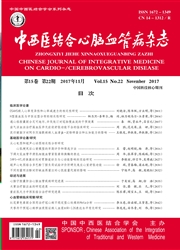

 中文摘要:
中文摘要:
目的探索腹型肥胖高血压病人中医证型分布特点,并分析"痰瘀"病理因素与腹型肥胖高血压相关性,为中西医结合有效控制肥胖高血压及防治靶器官损害提供一定的依据。方法采用横断面流行病学调查方法,共纳入上海地区227例腹型肥胖高血压病人,采集一般资料、中医症状、糖脂代谢、早期肾脏损害指标、心脏超声等,结合四诊进行中医辨证,按有无痰瘀兼夹证进行比较,对相关数据进行统计分析。结果腹型肥胖高血压病人中肝火亢盛证76例(33.5%),阴虚阳亢证42例(18.5%),痰湿壅盛证84例(37.0%),阴阳两虚证23例(11.0%),兼有痰瘀互结证共106例(46.7%)。痰瘀互结组较非痰瘀互结组室间隔厚度、左室收缩末内径和左室重量指数(LVMI)显著升高(P〈0.05),痰瘀互结组较非痰瘀互结组合并症数目、合并冠心病比例(59.4%vs 43.8%)、糖化血红蛋白、胱抑素C、尿微量白蛋白(MA)/肌酐(Cr)和尿MA显著增加(P〈0.05)。结论上海地区腹型肥胖高血压的中医证型以痰瘀互结证居多;痰瘀互结证易发生左室肥厚,且冠心病患病率和早期肾损害指标更高。
 英文摘要:
英文摘要:
Objective To explore the characteristics of traditional Chinese medicine(TCM)syndrome type in patients with central obesity hypertension,and analysis the correlation between the phlegm and blood stasis pathological factors and central obesity hypertension.The results of this study will provide a basis for the prevention and treatment of target organ damage in obesity hypertension with the integrated traditional Chinese and Western Medicine method.Methods This study used the cross-sectional epidemiological method,and a total of 227 cases of central obesity with essential hypertension patients were enrolled in this study.The general information,TCM symptoms,glucose and lipid metabolism factors,early stage index of kidney damage and index of echocardiography were collected.Further,TCM symptoms were classified by combining the four diagnostic methods of TCM.The collected data were analyzed.The data were analyzed by grouping the cases according to with or without phlegm and blood stasis syndrome.Results In this study,76 cases(33.5%) had Liver fire hyperactivity syndrome,42 cases(18.5%)had yin deficiency and yang-excess syndrome,84 cases(37.0%) had excessive phlegm-dampness syndrome,and 23 cases(11.0%)had yin and yang deficiency syndrome.106 patients(46.7%) had phlegm-blood stasis syndrome.The in terventricular septum thickness,ventricular septal thickness,left ventricular end diastolic diameter and left ventricular mass index(LVMI)of phlegm and blood stasis syndrome group were significantly higher than the nonphlegm and blood stasis syndrome group(P〈0.05).The number of consolidated disease,the proportion with coronary heart disease ratio(59.4% vs 43.8%),glycosylated hemoglobin,cystatin C,urinary MA/Cr and MA were significantly higher in phlegm and blood stasis syndrome group(P〈0.05).Conclusion The phlegm and blood stasis syndrome was the central obesity and hypertension in Shanghai area.The central obesity hypertensive patients with phlegm and blood stasis syndrome were pron
 同期刊论文项目
同期刊论文项目
 同项目期刊论文
同项目期刊论文
 期刊信息
期刊信息
